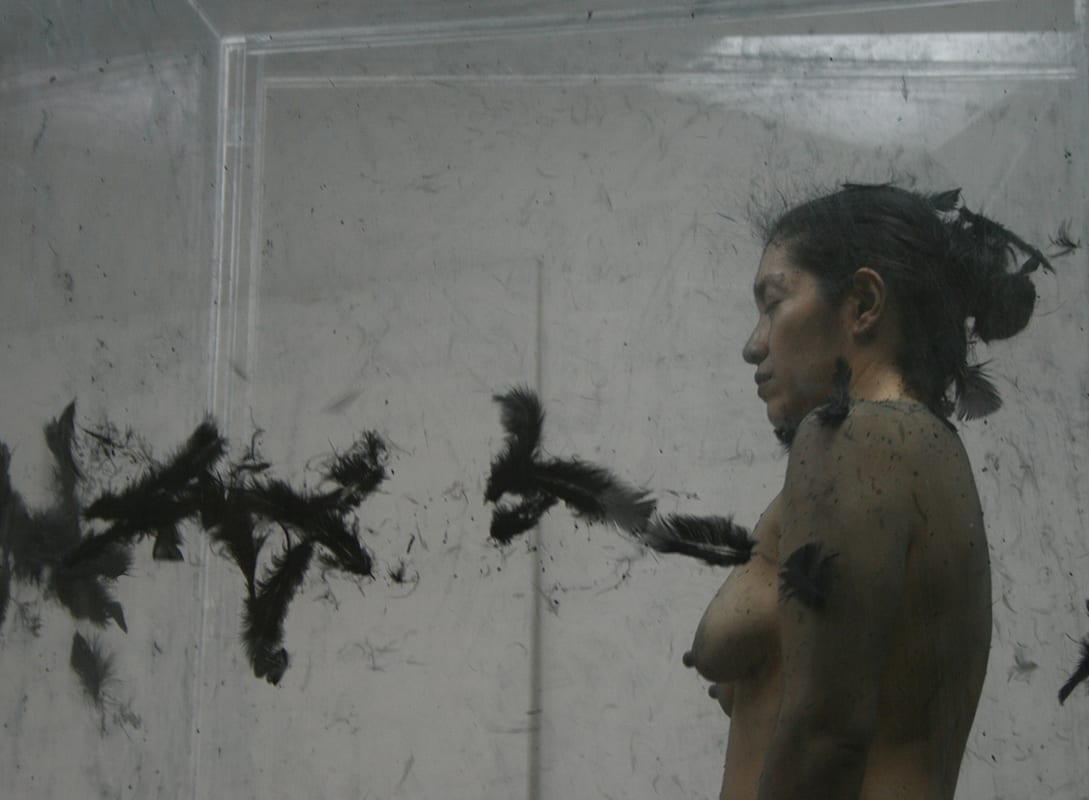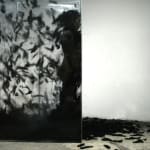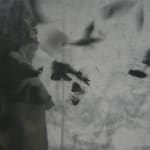Sandra Monterroso Guatemalan, b. 1974
La Devolución del Penacho de Vucub Caquix, 2014
Video-Performance
Duration 1:05 mins.
Further images
Link to video extract: https://www.youtube.com/watch?v=rhtCz4WZxO0 La Devolución del Penacho de Vucub Caquix (The Return of Vucub Caquix’s Feather Crown, 2014) revitalizes a specific motif from indigenous cosmological knowledge. In this...
Link to video extract:
https://www.youtube.com/watch?v=rhtCz4WZxO0
La Devolución del Penacho de Vucub Caquix (The Return of Vucub Caquix’s Feather Crown, 2014) revitalizes a specific motif from indigenous cosmological knowledge. In this work, Monterroso references the tale of Vucub Caquix, a bird demon in Maya cosmology that personifies the mortal vices of pride, wrath, vanity, lust, jealousy, and greed. In the story, Vucub Caquix equates himself to the gods by pretending to be the Sun and the Moon and is consequently punished by Hunahpu, one of the Maya twin heroes. The tale, which has been known since 200 BCE, is an allegory of the defeat of evil and the return of harmony. To make manifest this ancient mythological story, Monterroso places herself naked inside a rectangular structure made of transparent Plexiglas. Standing inside, the artist is showered by hundreds of black feathers as she slowly turns around. The feathers pile up on top of her shoulders and in between her hands. The shower of black feathers results in her body being covered in black, while the transparency of the Plexiglas is also tainted. The play between clarity and opacity reveals the borderlines of truth, alluding to the ways in which the vices of the conquest are still evident today.
The feathers further allude to a controversial dispute over Moctezuma’s iconic sixteenth-century Penacho (feather headdress), which is today housed in the Weltmuseum in Vienna. Referencing the dispute over the rightful return of Moctezuma’s feather headdress to Mexico, which Austrian government and museum officials have refused, the artist asks: “Who should this woman, the artist acting as the representative of those who fell during the conquest five hundred years ago, be returning Moctezuma’s feather crown to?” At first, this articulation evokes the dispute between Mexico and Austria over the Penacho, but it also confronts the logic of colonization and encourages more questioning—why not return it to the Aztecs, who are the rightful heirs of this cultural patrimony? Is it because there are no surviving Aztec communities in present-day Mexico, or, more likely, because the rhetoric of colonization has made illegitimate their claim to history? In addition, by simultaneously referencing two distinct Mesoamerican groups, the Maya and the Aztec, the artist is more broadly addressing a long-standing pan-indigenous concern about cultural appropriation and sovereignty.
Taken from Sara Gazon’s essay Sandra Monterroso: Cultural Subversions in Hemisphere: Visual Cultures of the Americas Volume 8, Issue 1 (2015)
https://www.youtube.com/watch?v=rhtCz4WZxO0
La Devolución del Penacho de Vucub Caquix (The Return of Vucub Caquix’s Feather Crown, 2014) revitalizes a specific motif from indigenous cosmological knowledge. In this work, Monterroso references the tale of Vucub Caquix, a bird demon in Maya cosmology that personifies the mortal vices of pride, wrath, vanity, lust, jealousy, and greed. In the story, Vucub Caquix equates himself to the gods by pretending to be the Sun and the Moon and is consequently punished by Hunahpu, one of the Maya twin heroes. The tale, which has been known since 200 BCE, is an allegory of the defeat of evil and the return of harmony. To make manifest this ancient mythological story, Monterroso places herself naked inside a rectangular structure made of transparent Plexiglas. Standing inside, the artist is showered by hundreds of black feathers as she slowly turns around. The feathers pile up on top of her shoulders and in between her hands. The shower of black feathers results in her body being covered in black, while the transparency of the Plexiglas is also tainted. The play between clarity and opacity reveals the borderlines of truth, alluding to the ways in which the vices of the conquest are still evident today.
The feathers further allude to a controversial dispute over Moctezuma’s iconic sixteenth-century Penacho (feather headdress), which is today housed in the Weltmuseum in Vienna. Referencing the dispute over the rightful return of Moctezuma’s feather headdress to Mexico, which Austrian government and museum officials have refused, the artist asks: “Who should this woman, the artist acting as the representative of those who fell during the conquest five hundred years ago, be returning Moctezuma’s feather crown to?” At first, this articulation evokes the dispute between Mexico and Austria over the Penacho, but it also confronts the logic of colonization and encourages more questioning—why not return it to the Aztecs, who are the rightful heirs of this cultural patrimony? Is it because there are no surviving Aztec communities in present-day Mexico, or, more likely, because the rhetoric of colonization has made illegitimate their claim to history? In addition, by simultaneously referencing two distinct Mesoamerican groups, the Maya and the Aztec, the artist is more broadly addressing a long-standing pan-indigenous concern about cultural appropriation and sovereignty.
Taken from Sara Gazon’s essay Sandra Monterroso: Cultural Subversions in Hemisphere: Visual Cultures of the Americas Volume 8, Issue 1 (2015)





